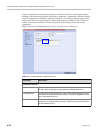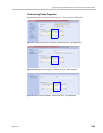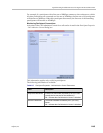
Polycom® RealPresence Collaboration Server (RMX) 1500/2000/4000 Administrator’s Guide
H-64 Polycom, Inc.
Collaboration Server Configuration for CAC Implementation
Enabling CAC Implementation
CAC is enabled by manually adding the flags to the system Configuration and setting their
values as follows:
• To enable the Call Admission Control implementation in the Collaboration Server:
— CAC_ENABLE=YES
• In addition, to ensure that endpoints such as HDX remain connected to the conference
for its duration when the Collaboration Server is configured with FQDN address and
the Lync server is working with load balancing and holds more than one address, the
following two flags must be manually added and set to:
— MS_KEEP_ALIVE_ENABLE = YES
Note: Since the keep alive is only required when the Lync server is working with
load balancing and holds more than one address, the default value is NO.
— SIP_TCP_PORT_ADDR_STRATEGY = 1 (default setting)
• When Call Admission Control is enabled in the local network, by default the local the
ICE channel is closed after applying CAC bandwidth management.
To change and preserve the ICE channel open throughout the call:
— PRESERVE_ICE_CHANNEL_IN_CASE_OF_LOCAL_MODE=YES.
Conferencing Behavior
Continuous Presence Conferences
In Continuous Presence conference, Lync clients connect with any allocated bandwidth.
Video Switching Conferences
In Video Switching conferences, Lync clients must connect with the same line rate as the
conference, otherwise they will be connected as Secondary (Audio Only) participants.
Mitigation of the line rate requirement can be effected by modifying the system flag:
VSW_RATE_TOLERANCE_PERECENT.
This system flag determines the line rate tolerance.
Possible values are: 0 - 75.
Setting this flag to 0 (0% - default) determines no line rate tolerance and the participant must
connect at the conference line rate.
Setting this flag to a value between 1 and 75 determines the percentage of bandwidth that
can be deducted from the required bandwidth to allow participants to connect to the
conference.
For example, if you enter 20 (for 20%) as the flag value, the participant will be able to
connect to the conference if the allocated line rate is up to 20% lower than the conference line
rate (or between 80% to 100% of the required bandwidth). If the conference line rate is
1024Kbps, participant with a line rate between 819Kbps and 1024Kbps will be able to
connect to the conference.
When a tolerance is set, the Highest Common mechanism is enabled for the conference line
rate. When a participant with a lower line rate connects to the conference, the line rate of all
other connected participants is reduced accordingly and when that participant disconnects
from the conference, the line rate of the remaining participants is increased to the highest
possible rate common to all connected participants.


















